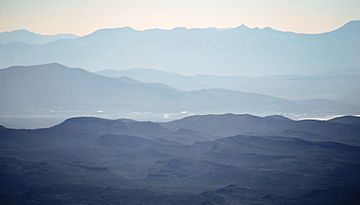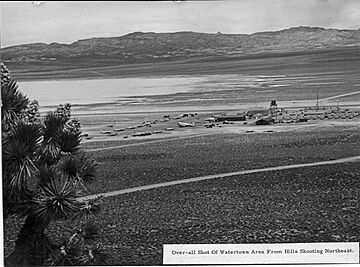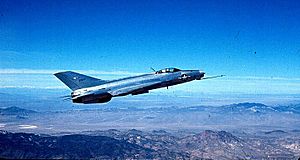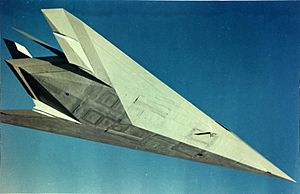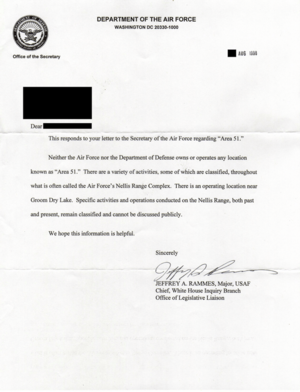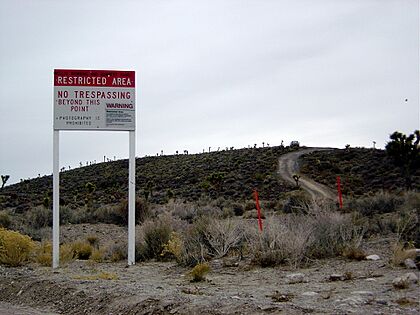Area 51 facts for kids
Quick facts for kids Homey Airport |
|||||||||||||||||
|---|---|---|---|---|---|---|---|---|---|---|---|---|---|---|---|---|---|
| Near Rachel, Lincoln County, Nevada in United States | |||||||||||||||||

A satellite image of Area 51 from 2022. The dry lakebed of Groom Lake is to the north.
|
|||||||||||||||||
 |
|||||||||||||||||
|
Location in the United States
|
|||||||||||||||||
| Coordinates | 37°14′0″N 115°48′30″W / 37.23333°N 115.80833°W | ||||||||||||||||
| Type | Development and testing facility | ||||||||||||||||
| Site information | |||||||||||||||||
| Owner | Department of Defense | ||||||||||||||||
| Operator | United States Air Force | ||||||||||||||||
| Controlled by | Air Force Materiel Command | ||||||||||||||||
| Open to the public |
No | ||||||||||||||||
| Condition | Operational | ||||||||||||||||
| Site history | |||||||||||||||||
| Built | 1955 (as Paradise Ranch) | ||||||||||||||||
| In use | 1955–present | ||||||||||||||||
| Events | Storm Area 51 (2019) | ||||||||||||||||
| Garrison information | |||||||||||||||||
| Garrison | Air Force Test Center (Detachment 3) | ||||||||||||||||
| Airfield information | |||||||||||||||||
| Identifiers | ICAO: KXTA, FAA LID: XTA | ||||||||||||||||
| Elevation | 4,494 feet (1,370 m) AMSL | ||||||||||||||||
|
|||||||||||||||||
Area 51 is the famous nickname for a top-secret United States Air Force (USAF) base located deep in the Nevada desert, about 83 miles (134 km) north of Las Vegas. Its official names are Homey Airport and Groom Lake.
For many years, the U.S. government did not officially say that Area 51 existed. The base's main purpose is to develop and test new, experimental aircraft and weapons. Because it is so secret, Area 51 has become a huge part of stories and conspiracy theories about unidentified flying objects (UFOs) and aliens.
The area around the base is a popular spot for tourists. The nearby town of Rachel is on a road that Nevada has officially named the "Extraterrestrial Highway".
Contents
Location and Geography
Area 51 is in a very remote part of the Nevada desert. It sits next to a large, dry salt flat called Groom Lake. This flat, hard surface makes a perfect natural runway for testing airplanes.
The base is surrounded by mountains and is part of a huge, restricted military area called the Nevada Test and Training Range. This makes it very hard for anyone to get close or see what is happening inside. The area is so protected that it even shares a border with the Nevada Test Site, where nuclear weapons were once tested.
A History of Secret Planes
The base at Groom Lake was built in 1955. Its remote location was perfect for keeping new airplane technology a secret.
The U-2 Spy Plane
The first major project at Area 51 was the Lockheed U-2 spy plane. This was a top-secret aircraft designed to fly higher than any other plane at the time. It could take pictures from over 70,000 feet in the air.
The Central Intelligence Agency (CIA) needed a secret place to test the U-2. The project's leaders flew over the Nevada desert and found Groom Lake. One of the plane's designers, Kelly Johnson, said, "within thirty seconds, you knew that was the place." The dry lake was a "perfect natural landing field." To make the secret base sound more appealing to workers, Johnson called it "Paradise Ranch."
The Super-Fast A-12 (Project OXCART)
After the U-2, Area 51 became home to an even more amazing aircraft: the Lockheed A-12. This was part of a secret project called OXCART. The A-12 was a spy plane that could fly faster than three times the speed of sound (over 2,000 miles per hour).
To handle this new plane, the base had to be made much bigger. A new, longer runway was built, along with new hangars, fuel tanks, and housing for over 1,000 people. The A-12 was so fast and flew so high that pilots from other planes often saw it and thought it was a UFO.
Studying Planes from Other Countries
During the Cold War, the U.S. military secretly got its hands on fighter jets made by the Soviet Union, like the MiG-21 and MiG-17. These planes were brought to Area 51 to be studied and flown.
American pilots would fly the MiGs in mock dogfights against U.S. planes like the F-4 Phantom II. This helped them understand how the Soviet planes worked and find their weaknesses. The lessons learned from these secret tests helped train American pilots and gave them an advantage in real combat. This program was so secret that the airspace over Groom Lake was called "Red Square" on maps, as a joke about the famous square in Moscow.
The First Stealth Fighter: The F-117 Nighthawk
One of the most famous projects at Area 51 was the creation of stealth technology. This led to the F-117 Nighthawk, the world's first operational stealth aircraft. A stealth plane is designed to be very hard for radar to detect.
The project started with a prototype called Lockheed Have Blue. It had a strange shape made of flat panels, which helped to scatter radar waves. After successful tests at Area 51, the full-sized F-117 was developed. The first F-117 flew at the base on June 18, 1981. For years, the F-117 program remained a secret, with the planes flying only at night from a remote airfield.
A Top-Secret Location
For decades, the U.S. government would not admit that Area 51 existed. If asked, officials would only say it was part of the Nellis Air Force Base complex.
Finally, on June 25, 2013, the Central Intelligence Agency (CIA) released documents that officially acknowledged the base's existence. The documents were released because of a request made under the Freedom of Information Act. They confirmed that Area 51 was used to test the U-2 and A-12 spy planes.
Security at the Base
Area 51 is one of the most heavily guarded places on Earth. The perimeter is marked with orange posts and warning signs. Guards in white pickup trucks, often called "camo dudes" by tourists, patrol the border.
The signs warn that photography is forbidden and that security is authorized to use deadly force against trespassers. The base also uses motion sensors and surveillance cameras to watch its borders. It is impossible for the public to get close to the base.
Why is Area 51 Linked to Aliens?
The extreme secrecy around Area 51 has led to many conspiracy theories, especially ones involving aliens and UFOs. Some of the most popular stories claim that the base is used for:
- Storing and studying crashed alien spacecraft, like the one from the Roswell incident.
- Meeting with extraterrestrials.
- Developing new technology based on alien ships.
- Building secret underground tunnels and facilities.
The Real Reason for "UFO" Sightings
Most historians and former base employees believe there is a simple explanation for the UFO stories. In the 1950s and 1960s, secret planes like the U-2 and A-12 flew much higher and faster than any other aircraft.
When people, including other pilots, saw these strange-looking, shiny metal objects flying at incredible speeds, they didn't know what they were. The government couldn't tell them they were secret spy planes, so the sightings were often labeled as UFOs. The secrecy actually helped protect the real projects happening at the base.
"Storm Area 51"
In 2019, a joke event on Facebook called "Storm Area 51, They Can't Stop All of Us" went viral. Millions of people signed up online, promising to raid the base to "see them aliens."
On the scheduled day, only a few thousand people showed up in the nearby towns, and no one tried to storm the base. The event turned into a peaceful festival celebrating the mystery of Area 51. It showed how much the secret base has become a part of popular culture.
Images for kids
See also
 In Spanish: Área 51 para niños
In Spanish: Área 51 para niños
- Area 52
- Black operation
- Black project
- Black site
- List of United States Air Force installations
- Special access program



